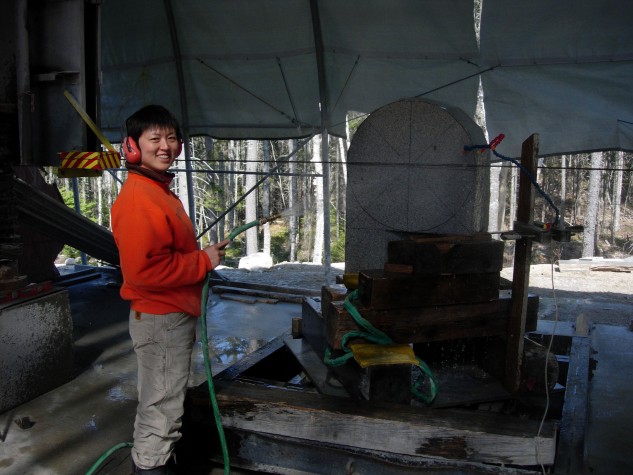Earth Spirits
The act of sculpting raw materials into a work of art is a visceral process that taps into the primitive, elemental aspects of nature. Kazumi Hoshino, Antoinette Prien Schultze, and Richard Alden transform stone into sculptures inspired by the vitality of the natural world.
Kazumi Hoshino
Maine’s rural landscapes inspire Hoshino, who enjoys living close to nature. But, she notes, “my work is also contemporary, and although I use the ancient material of stone, my imagery is intuitive and conceptual.” Those descriptors could easily apply to her creative process as well. “Carving stone is an exploration of time and self-discovery for me,” explains Hoshino. “My work is not the expression of an inner self, but more a way of opening myself.” Describing her work as “a fusion of tradition, nature, and my surrounding world,” Hoshino demonstrates an inclusive attitude toward art. Her clean, pared-down forms are unassuming, which she hopes makes them resonate with viewers. She is happy for people to devise their own meanings for her sculptures.
Composition Trio is part of the Composition Series, which Hoshino says displays “the variety and complexity that is derived from a simple form.” Composed of three interconnected ovoid forms, Composition Trio is characterized by an elegance and purity of line. The smooth, undulating curves and unadorned surface allow for myriad interpretations: they could be eggs or beach rocks or multiplying cells. The simplicity of Hoshino’s sculptures invites endless discovery and contemplation, because not everything is spelled out for the viewer. In this case, even Hoshino is inspired, and challenged, by the creative potential of simplicity. “When I just focus on making the combination of simple forms, it provides infinite possibilities to me,” she says. The piece is included in the 14th annual Sculpture Garden Invitational at the Art Gallery at University of New England in Portland, on view through October.
Antoinette Prien Schultze
Although Schultze had a longtime appreciation of and talent for the visual arts, she did not pursue them professionally at first. “It never occurred to me to be an artist,” she says. While living in Portsmouth, New Hampshire, Schultze would travel regularly to Boston and New York City to study opera. After moving to Maine in 1968 with her husband and children, she found that traveling became too difficult. “I had to give up family or singing,” Schultze says. “But at the same time, I knew that I had to fill the creativity and enormous energy that singing required with something similar, so I started carving, and I found that it provided a place to use my energy and my need to express myself.”
For Schultze, glass adds a necessary “expression of frailty” to her sculptures. The colored glass reveals “an inner passion,” which, for Schultze, imparts her sculptures with humanity. The delicate beauty of glass contrasts with the rough solidity of stone, introducing a dynamic tension into her work. In One and the Other, orange quartz complements the warm tones of the granite. The quartz rises up out of the stone like the morning sun, its bright hue radiating “peaceful joy,” according to Schultze.
Richard Alden
“I enjoy the mentally and physically intensive process of carving and shaping my pieces to exude a rhythmic motion, balance, and harmony in the final composition,” Alden says. “The challenge is to capture that special spirit and emotion within each sculpture.” Alden credits friends, mentors, and fellow sculptors with encouraging his art, noting that they have “immensely fostered my development as a professional sculptor.” Inspired by the exchange of ideas and moral support offered by this network of friends and colleagues, Alden strives to be as helpful as he can to others, facilitating a collaborative aspect to the art of sculpture.
The appropriately titled A Beautiful Mind arose out of just such a collaborative exchange. Created during a workshop led by French sculptor Nicole Durand, A Beautiful Mind was inspired by the natural form and texture of the stone itself. Says Alden, Durand encouraged him to “[run] a rasp along the ridges of a raw stone until the spirit revealed itself, which it did when a prominent hip came into focus.” Alden’s minimalistic style allows the “voluptuous figure” to shine through, without unnecessary flourishes. The figure’s face is particularly interesting, as it is “half natural stone and half as sawn from its mining,” Alden explains. Devoid of any identifying features, the figure can act as a universal Everywoman, a totemic symbol representing both inner and outer beauty. For Alden, the piece evokes a sense of “inner harmony,” the confidence of a woman who is “comfortable with her whole body and soul.”





